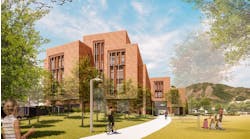Academic institutions have been among the leading proponents of sustainable design. Many see environmental education and stewardship as part of their broad mission. As long-term owners, they are in a position to gain a substantial return on their investments in sustainable-design strategies. To reap the rewards of sustainable design, an institution and its project team should work to integrate sustainability into a project from the outset.
At the beginning
At the outset of project planning, schools and universities should identify sustainable design as a priority to ensure that it becomes an integral part of the design and construction process. Many early decisions have a significant impact on sustainability, such as site selection, and building orientation and form. When sustainability is a priority, the education institution and project team are more likely to find ways to “make it happen” when decisions on costs are being made.
One of the most difficult obstacles for an education institution to overcome is the conventional separation of the capital budget from the maintenance and operations (M&O) budget. Some sustainable design strategies may have higher capital costs, but they deliver significant savings on M&O costs over the building's life and often have a relatively short payback period.
Many institutions struggle with the question of whether to seek certification under the U.S. Green Building Council's LEED (Leadership in Energy and Environmental Design) Green Building Rating System. The costs of the registration, documentation and review processes are a legitimate concern. Some of the advantages of setting formal LEED certification as a goal are that it provides a framework for sustainable design, requires energy modeling and commissioning, and forces accountability. It also can create a marketing advantage for an institution.
Collaborative design
Just as identifying sustainability as a fundamental project goal is essential to achieving a high-performance building, so is collaboration among the design, engineering and construction disciplines. A holistic, value-based solution can be achieved only by tapping the collective expertise and experience of the project team.
Often overlooked is the importance of involving the general contractor or construction manager early in the process to perform estimating and constructability studies. An institution's representative also needs to be at the table to participate in the decisionmaking process.
Energy modeling is required of any project seeking LEED certification, but it should be a fundamental part of every sustainable building project. Energy modeling enables the project team to model the building's energy performance when various systems are incorporated into the design, project the costs and energy savings, and identify the systems that will maximize return on investment over the building's life cycle.
Key issues, strategies and systems that the project team should examine as they develop a sustainable solution:
-
Siting, orientation and form: placement of a new building to minimize its impact on the environment; building orientation; building form; maximizing natural ventilation and light while avoiding unwanted heat gain.
-
Building envelope: effect of alternative wall systems on the thermal performance of the building envelope; types of insulation.
-
Mechanical systems: high-efficiency mechanical units; energy-recovery units; carbon-dioxide sensors to reduce outside-air requirements while removing “stale” air when areas are periodically occupied; free cooling during certain seasons.
-
Roofing: effect of the roofing product on heating and cooling loads, and associated size and operating cost of the mechanical system, and on thermal stress (e.g., reflective roofing material).
-
Windows: identifying a system with no thermal breaks in the frame; and the type of glass that will meet project requirements cost-effectively, including multiple panes, low-e, argon-filled, and various tints and coatings.
-
Lighting: strategies to reduce dependence on artificial lighting through maximizing the amount of controlled daylight that penetrates the interior of the building; energy-efficient supplemental artificial lighting systems using energy-efficient light sources (e.g., HID and fluorescent) and cost-effective lighting controls (e.g., daylight dimming systems and occupancy sensors).
-
Building materials: selection of materials that are local, sustainably managed, recycled/recyclable, low VOC.
-
Smart purchasing: selection of Energy Star-qualified equipment and appliances; consider standardization and bulk purchasing to acquire higher-performance equipment at a lower cost.
Jankiewicz, AIA, NCARB, is president and founding partner of Design Collective, Inc., Baltimore, Md. Bernardo, AIA, LEED AP, is principal designer for the firm.

